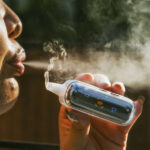Stressed? Vaping could make it worse



Honoring May as Mental Health Awareness Month, health professionals and anti-tobacco advocates are offering education on the connection between vaping and mental health issues.
“It’s ironic: A lot of people reach for a vape in times of stress, but the research is more pointing to the fact that the vape itself could be part of the stress increase,” said Jill Tamashiro, a public educator from the Hawaii Department of Health.
ADVERTISING
Statewide statistics from the DOH show that nearly 1 in 4 young adults aged 18 to 34 report current e-cigarette use, with some disposable vapes — which can last a user anywhere from a few days to a full month — containing as much as 650 mg of nicotine, the equivalent of 590 cigarettes.
The ease and discretion of vaping also can lead to more frequent consumption, making withdrawal symptoms like irritability, insomnia, anxiety and mood swings stronger.
Certified Tobacco Treatment Specialist Kai Carvalho from Hamakua-Kohala Health has been educating fourth- to 12th-graders at local schools about the impacts of smoking since 2017. Following a prevention and awareness curriculum developed by Stanford University, Carvalho visits each grade three times throughout the year, allowing kids to open up about their vaping exposure, including a sixth-grader who told her that they’d been vaping since the third grade.
“From what we’ve seen, they’re vaping more because they feel like it’s the only thing that might help them with the stress they’re going through … (involving) academic performance, relationships and family,” Carvalho said. She said she knows first-hand that the documented rates for Hawaii Island of 1 in every 5 sixth- to eighth-grade students and 1 out of 3 high school students using are accurate.
Tamashiro said studies have shown nicotine impacts the brain areas that control attention, learning, memory and impulse control, while at the same time elevating one’s heart rate, blood pressure and glucose.
She added that vapes are deeply under-regulated, causing the nicotine to often be more highly concentrated. Carvalho added that ingredients used in vapes beyond nicotine — including acetaldehyde, the common ingredient in hair spray which is used to give vapes strawberry flavoring — are equally detrimental.
“The basic things you’d find in e-juice are nicotine … acetaldehyde … and isoprene, which is what we find in air fresheners, so the cloud smells like (fruit),” Carvalho said. “Because it’s being aerosolized, (the chemicals) are actually breaking down into tinier molecules that are going deeper into the lungs … creating the perfect place for a respiratory illness known as ‘wet lung,’ which feels like drowning above water.”
The condition Carvalho discussed is also known as EVALI, E-Cigarette or Vaping Associated Lung Injury.
“The marketing has done a really good job of framing e-cigarettes as the better alternative. But it’s like saying something is not as toxic as a toxic waste dump, or it’s safer jumping off a 10-story building than a 100-story building,” Tamashiro said.
Carvalho said she witnesses elevated levels of anxiety in children immediately after vapes are confiscated, which she attributed to losing the physical habit of puffing every 30 minutes or less, and reduced self-confidence and higher levels of shame when youths realize how dependent they are on vaping.
Peer pressure not to vape is less prevalent than it was in the past for smoking combustible cigarettes, according to both the experts and studies. Carvalho said vaping has become such a norm throughout society that starting is a way of just keeping up with everyone around them.
She noted seeing middle school students posting videos of themselves vaping simply for the instant validation and guaranteed “likes” such content receives. A telling study also noted the “greater social acceptability and ubiquitous use of e-cigarettes” as a factor affecting public health.
That 2017 study by experts from Brown University, the University of Pennsylvania, and the University of Southern California examined the connection between e-cigarettes and depression primarily by mirroring three decades of studies that found a “well documented” association between nicotine found in combustible cigarettes and depression.
Examining nearly 450 subjects for a year, the scientists felt the “relationships observed in previous studies between combustible cigarettes and depressive symptoms are also present for e-cigarettes.”
The bi-directional findings — meaning the vaping led to depression while the depression led to more vaping — showed that “prolonged nicotine exposure can cause abnormal cerebral dopamine transmission, dysregulate emotional pathways underlying emotional processing, amplify stress sensitivity, and interfere with the development of adaptive coping strategies that buffer against the onset of depressive symptoms, particularly during adolescence when the developing brain is more vulnerable to nicotine-induced neurobiological insults.”
Carvalho said resources to help children develop healthier coping mechanisms include breathing exercises or sports, as well as a new hotline available to teens through the DOH’s “My Life, My Quit” program, where teens and their parents or guardians can learn about the effects of vaping and ways to quit at www.mylifemyquit.com.
Tamashiro said smoking in combustible or electronic form can be a gateway for other addictions, leading the DOH to implement a new pilot program in drug treatment facilities throughout the state called the Hawaii Behavior Health Initiative.
Tamashiro said this pilot program — inspired by the efforts of Dr. Hannah Preston-Pita at the Big Island Substance Abuse Council, who made the facility smoke-free in 2019 — offers patients such options as gardens to work in to turn smoke breaks into “wellness breaks.”
Tamashiro also said hydration is critical to both adolescents and adults kicking a substance habit because it helps flush toxins out of the body.
Quitting assistance for adults can include utilizing nicotine patches, gum or lozenges, gaining support from in-person or over-the-phone tobacco treatment and coaching, or calling the free, confidential Hawaii Tobacco Quitline at 1-800-QUIT-NOW (1-800-784-8669).
Email Kyveli Diener at kdiener@hawaiitribune-herald.com.







